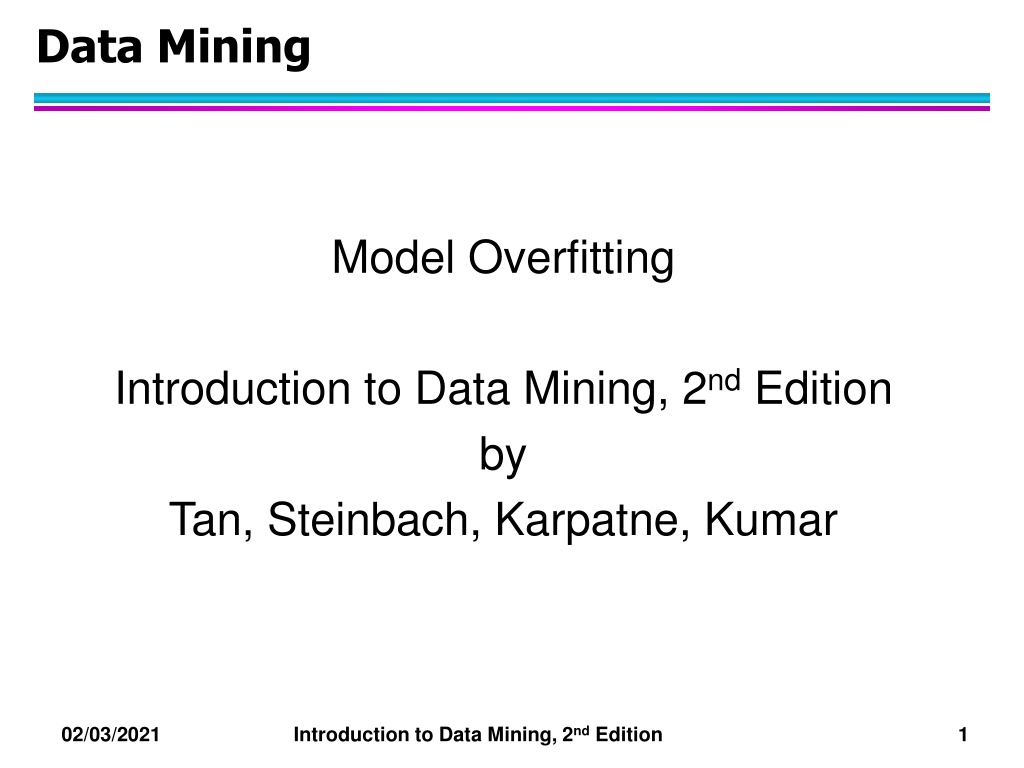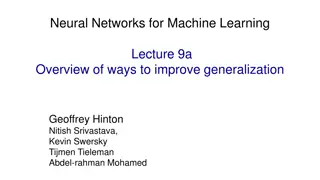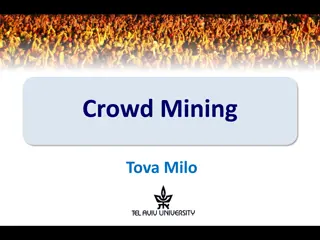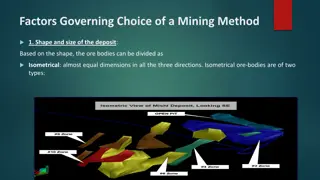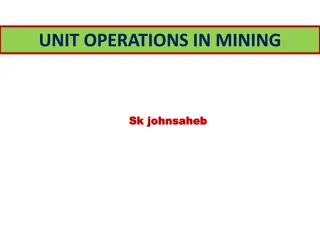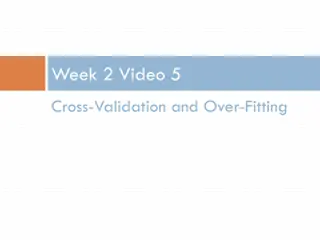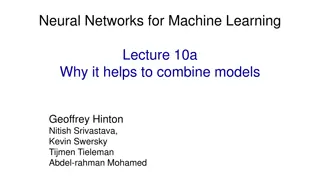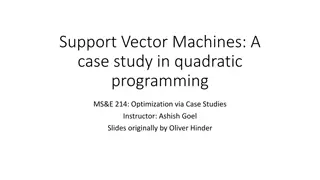Understanding Overfitting in Data Mining Models
Overfitting is a common issue in data mining models where the model performs exceptionally well on the training data but fails to generalize to new data. This content discusses how overfitting can occur, its impact on model performance, and strategies to mitigate it. Through examples and visualizations, it demonstrates the consequences of overfitting, such as increased errors on the test set and poor generalization. Additionally, it explores the trade-off between model complexity and performance, specifically focusing on decision trees with varying numbers of nodes. The comparison between decision trees with 4 and 50 nodes illustrates the concept of overfitting and the importance of finding the right balance to achieve optimal model performance.
Download Presentation

Please find below an Image/Link to download the presentation.
The content on the website is provided AS IS for your information and personal use only. It may not be sold, licensed, or shared on other websites without obtaining consent from the author. Download presentation by click this link. If you encounter any issues during the download, it is possible that the publisher has removed the file from their server.
E N D
Presentation Transcript
Data Mining Model Overfitting Introduction to Data Mining, 2nd Edition by Tan, Steinbach, Karpatne, Kumar 02/03/2021 Introduction to Data Mining, 2ndEdition 1
Classification Errors Training errors: Errors committed on the training set Test errors: Errors committed on the test set Generalization errors: Expected error of a model over random selection of records from same distribution Learning algorithm Attrib1 Attrib2 Attrib3 Class Tid No 1 Yes Large 125K No 2 No Medium 100K No 3 No Small 70K Induction No 4 Yes Medium 120K Yes 5 No Large 95K No 6 No Medium 60K Learn Model No 7 Yes Large 220K Yes 8 No Small 85K No 9 No Medium 75K Yes 10 No Small 90K Model 10 Training Set Apply Model Attrib1 Attrib2 Attrib3 Class Tid ? 11 No Small 55K ? 12 Yes Medium 80K Deduction ? 13 Yes Large 110K ? 14 No Small 95K ? 15 No Large 67K 10 Test Set 02/03/2021 Introduction to Data Mining, 2nd Edition 2
Example Data Set Two class problem: + : 5400 instances 5000 instances generated from a Gaussian centered at (10,10) 400 noisy instances added o : 5400 instances Generated from a uniform distribution 10 % of the data used for training and 90% of the data used for testing 02/03/2021 Introduction to Data Mining, 2nd Edition 3
Increasing number of nodes in Decision Trees 02/03/2021 Introduction to Data Mining, 2nd Edition 4
Decision Tree with 4 nodes Decision Tree Decision boundaries on Training data 02/03/2021 Introduction to Data Mining, 2nd Edition 5
Decision Tree with 50 nodes Decision Tree Decision Tree Decision boundaries on Training data 02/03/2021 Introduction to Data Mining, 2nd Edition 6
Which tree is better? Decision Tree with 4 nodes Which tree is better ? Decision Tree with 50 nodes 02/03/2021 Introduction to Data Mining, 2nd Edition 7
Model Underfitting and Overfitting As the model becomes more and more complex, test errors can start increasing even though training error may be decreasing Underfitting: when model is too simple, both training and test errors are large Overfitting: when model is too complex, training error is small but test error is large 02/03/2021 Introduction to Data Mining, 2nd Edition 8
Model Overfitting Impact of Training Data Size Using twice the number of data instances Increasing the size of training data reduces the difference between training and testing errors at a given size of model 02/03/2021 Introduction to Data Mining, 2nd Edition 9
Model Overfitting Impact of Training Data Size Decision Tree with 50 nodes Decision Tree with 50 nodes Using twice the number of data instances Increasing the size of training data reduces the difference between training and testing errors at a given size of model 02/03/2021 Introduction to Data Mining, 2nd Edition 10
Reasons for Model Overfitting Not enough training data High model complexity Multiple Comparison Procedure 02/03/2021 Introduction to Data Mining, 2nd Edition 11
Effect of Multiple Comparison Procedure Consider the task of predicting whether stock market will rise/fall in the next 10 trading days Day 1 Day 2 Day 3 Day 4 Day 5 Day 6 Day 7 Day 8 Day 9 Day 10 Up Down Down Up Down Down Up Up Up Down Random guessing: P(correct) = 0.5 Make 10 random guesses in a row: 10 10 10 + + 8 9 10 10 = = (# ) 8 0547 . 0 P correct 2 02/03/2021 Introduction to Data Mining, 2nd Edition 12
Effect of Multiple Comparison Procedure Approach: Get 50 analysts Each analyst makes 10 random guesses Choose the analyst that makes the most number of correct predictions Probability that at least one analyst makes at least 8 correct predictions = 50= (# ) 8 1 1 ( . 0 0547 ) . 0 9399 P correct 02/03/2021 Introduction to Data Mining, 2nd Edition 13
Effect of Multiple Comparison Procedure Many algorithms employ the following greedy strategy: Initial model: M Alternative model: M = M , where is a component to be added to the model (e.g., a test condition of a decision tree) Keep M if improvement, (M,M ) > Often times, is chosen from a set of alternative components, = { 1, 2, , k} If many alternatives are available, one may inadvertently add irrelevant components to the model, resulting in model overfitting 02/03/2021 Introduction to Data Mining, 2nd Edition 14
Effect of Multiple Comparison - Example Use additional 100 noisy variables generated from a uniform distribution along with X and Y as attributes. Use 30% of the data for training and 70% of the data for testing Using only X and Y as attributes 02/03/2021 Introduction to Data Mining, 2nd Edition 15
Notes on Overfitting Overfitting results in decision trees that are more complex than necessary Training error does not provide a good estimate of how well the tree will perform on previously unseen records Need ways for estimating generalization errors 02/03/2021 Introduction to Data Mining, 2nd Edition 16
Model Selection Performed during model building Purpose is to ensure that model is not overly complex (to avoid overfitting) Need to estimate generalization error Using Validation Set Incorporating Model Complexity 02/03/2021 Introduction to Data Mining, 2nd Edition 17
Model Selection: Using Validation Set Divide training data into two parts: Training set: use for model building Validation set: use for estimating generalization error Note: validation set is not the same as test set Drawback: Less data available for training 02/03/2021 Introduction to Data Mining, 2nd Edition 18
Model Selection: Incorporating Model Complexity Rationale: Occam s Razor Given two models of similar generalization errors, one should prefer the simpler model over the more complex model A complex model has a greater chance of being fitted accidentally Therefore, one should include model complexity when evaluating a model Gen. Error(Model) = Train. Error(Model, Train. Data) + x Complexity(Model) 02/03/2021 Introduction to Data Mining, 2nd Edition 19
Estimating the Complexity of Decision Trees Pessimistic Error Estimate of decision tree T with k leaf nodes: err(T): error rate on all training records : trade-off hyper-parameter (similar to ) Relative cost of adding a leaf node k: number of leaf nodes Ntrain: total number of training records 02/03/2021 Introduction to Data Mining, 2nd Edition 20
Estimating the Complexity of Decision Trees: Example e(TL) = 4/24 +: 3 -: 0 +: 5 -: 2 +: 3 -: 6 +: 1 -: 4 +: 3 -: 0 e(TR) = 6/24 = 1 +: 3 -: 1 +: 0 -: 5 +: 3 -: 1 +: 2 -: 1 +: 0 -: 2 +: 1 -: 2 Decision Tree, TL Decision Tree, TR egen(TL) = 4/24 + 1*7/24 = 11/24 = 0.458 egen(TR) = 6/24 + 1*4/24 = 10/24 = 0.417 02/03/2021 Introduction to Data Mining, 2nd Edition 21
Estimating the Complexity of Decision Trees Resubstitution Estimate: Using training error as an optimistic estimate of generalization error Referred to as optimistic error estimate e(TL) = 4/24 e(TR) = 6/24 +: 3 -: 0 +: 5 -: 2 +: 3 -: 6 +: 1 -: 4 +: 3 -: 0 +: 3 -: 1 +: 0 -: 5 +: 3 -: 1 +: 2 -: 1 +: 0 -: 2 +: 1 -: 2 Decision Tree, TL Decision Tree, TR 02/03/2021 Introduction to Data Mining, 2nd Edition 22
Minimum Description Length (MDL) A? y 1 0 0 1 X X1 X2 X3 X4 Xn Yes No y ? ? ? ? X X1 X2 X3 X4 Xn 0 B? B1 B2 C? 1 A B C1 C2 0 1 1 ? Cost(Model,Data) = Cost(Data|Model) + x Cost(Model) Cost is the number of bits needed for encoding. Search for the least costly model. Cost(Data|Model) encodes the misclassification errors. Cost(Model) uses node encoding (number of children) plus splitting condition encoding. 02/03/2021 Introduction to Data Mining, 2nd Edition 23
Model Selection for Decision Trees Pre-Pruning (Early Stopping Rule) Stop the algorithm before it becomes a fully-grown tree Typical stopping conditions for a node: Stop if all instances belong to the same class Stop if all the attribute values are the same More restrictive conditions: Stop if number of instances is less than some user-specified threshold Stop if class distribution of instances are independent of the available features (e.g., using 2 test) Stop if expanding the current node does not improve impurity measures (e.g., Gini or information gain). Stop if estimated generalization error falls below certain threshold 02/03/2021 Introduction to Data Mining, 2nd Edition 24
Model Selection for Decision Trees Post-pruning Grow decision tree to its entirety Subtree replacement Trim the nodes of the decision tree in a bottom-up fashion If generalization error improves after trimming, replace sub-tree by a leaf node Class label of leaf node is determined from majority class of instances in the sub-tree 02/03/2021 Introduction to Data Mining, 2nd Edition 25
Example of Post-Pruning Training Error (Before splitting) = 10/30 Pessimistic error = (10 + 0.5)/30 = 10.5/30 Class = Yes 20 Training Error (After splitting) = 9/30 Class = No Error = 10/30 10 Pessimistic error (After splitting) = (9 + 4 0.5)/30 = 11/30 PRUNE! A? A1 A4 A3 A2 Class = Yes Class = No 8 4 Class = Yes Class = No 3 4 Class = Yes Class = No 4 1 Class = Yes Class = No 5 1 02/03/2021 Introduction to Data Mining, 2nd Edition 26
Examples of Post-pruning Decision Tree: depth = 1 : | breadth > 7 : class 1 | breadth <= 7 : | | breadth <= 3 : | | | ImagePages > 0.375 : class 0 | | | ImagePages <= 0.375 : | | | | totalPages <= 6 : class 1 | | | | totalPages > 6 : | | | | | breadth <= 1 : class 1 | | | | | breadth > 1 : class 0 | | width > 3 : | | | MultiIP = 0: | | | | ImagePages <= 0.1333 : class 1 | | | | ImagePages > 0.1333 : | | | | | breadth <= 6 : class 0 | | | | | breadth > 6 : class 1 | | | MultiIP = 1: | | | | TotalTime <= 361 : class 0 | | | | TotalTime > 361 : class 1 depth > 1 : | MultiAgent = 0: | | depth > 2 : class 0 | | depth <= 2 : | | | MultiIP = 1: class 0 | | | MultiIP = 0: | | | | breadth <= 6 : class 0 | | | | breadth > 6 : | | | | | RepeatedAccess <= 0.0322 : class 0 | | | | | RepeatedAccess > 0.0322 : class 1 | MultiAgent = 1: | | totalPages <= 81 : class 0 | | totalPages > 81 : class 1 Simplified Decision Tree: depth = 1 : | ImagePages <= 0.1333 : class 1 | ImagePages > 0.1333 : | | breadth <= 6 : class 0 | | breadth > 6 : class 1 depth > 1 : | MultiAgent = 0: class 0 | MultiAgent = 1: | | totalPages <= 81 : class 0 | | totalPages > 81 : class 1 Subtree Raising Subtree Replacement 02/03/2021 Introduction to Data Mining, 2nd Edition 27
Model Evaluation Purpose: To estimate performance of classifier on previously unseen data (test set) Holdout Reserve k% for training and (100-k)% for testing Random subsampling: repeated holdout Cross validation Partition data into k disjoint subsets k-fold: train on k-1 partitions, test on the remaining one Leave-one-out: k=n 02/03/2021 Introduction to Data Mining, 2nd Edition 28
Cross-validation Example 3-fold cross-validation 02/03/2021 Introduction to Data Mining, 2nd Edition 29
Variations on Cross-validation Repeated cross-validation Perform cross-validation a number of times Gives an estimate of the variance of the generalization error Stratified cross-validation Guarantee the same percentage of class labels in training and test Important when classes are imbalanced and the sample is small Use nested cross-validation approach for model selection and evaluation 02/03/2021 Introduction to Data Mining, 2nd Edition 30
